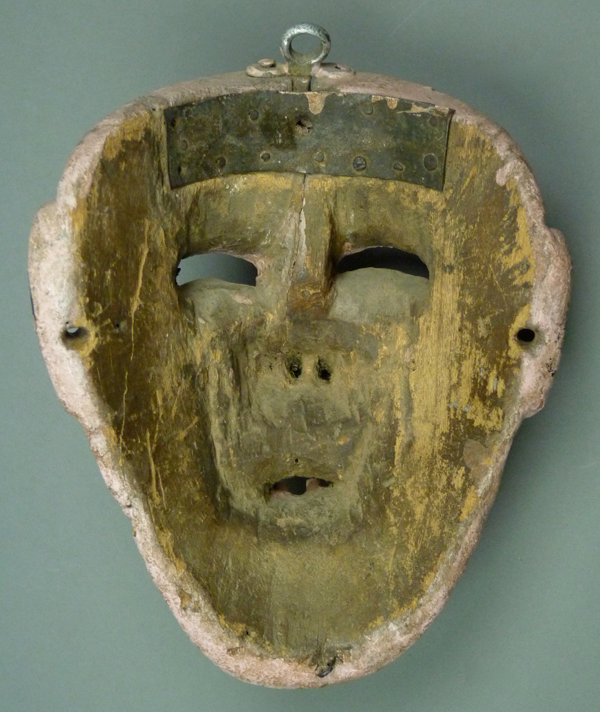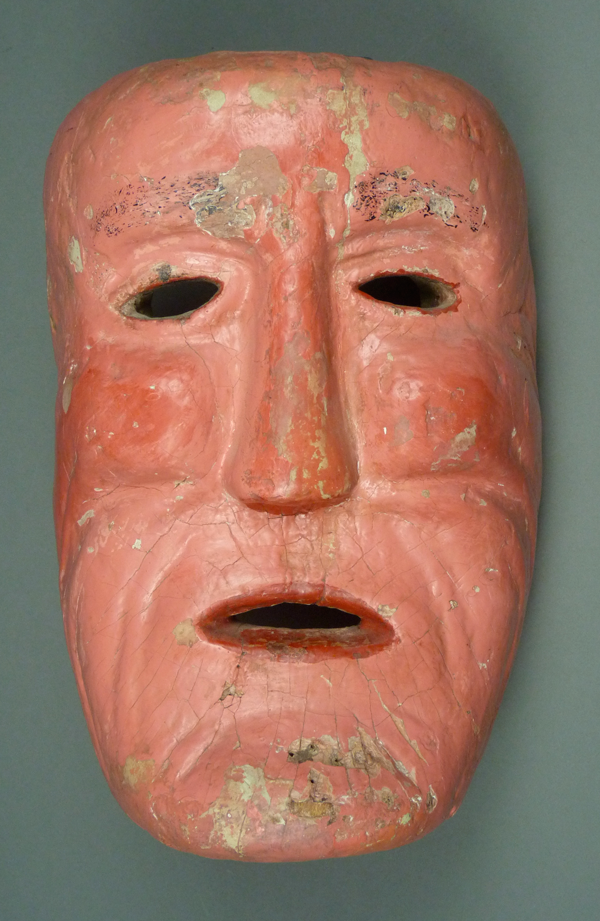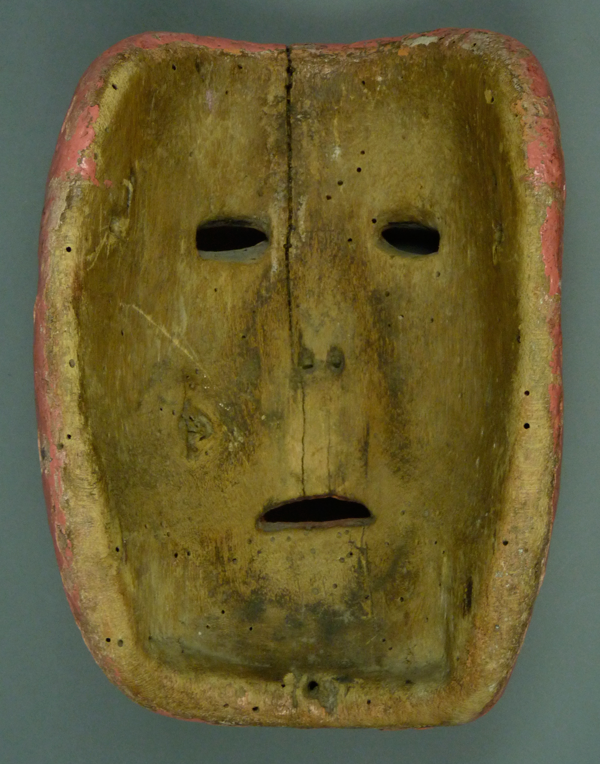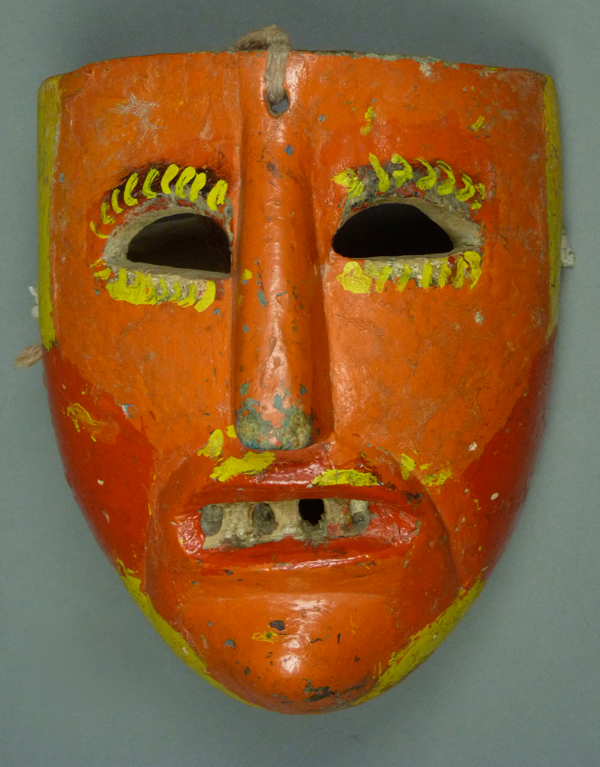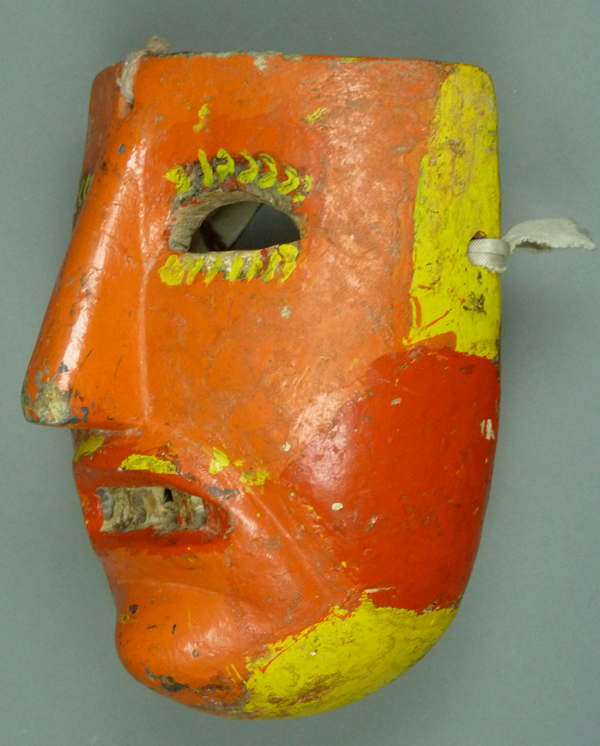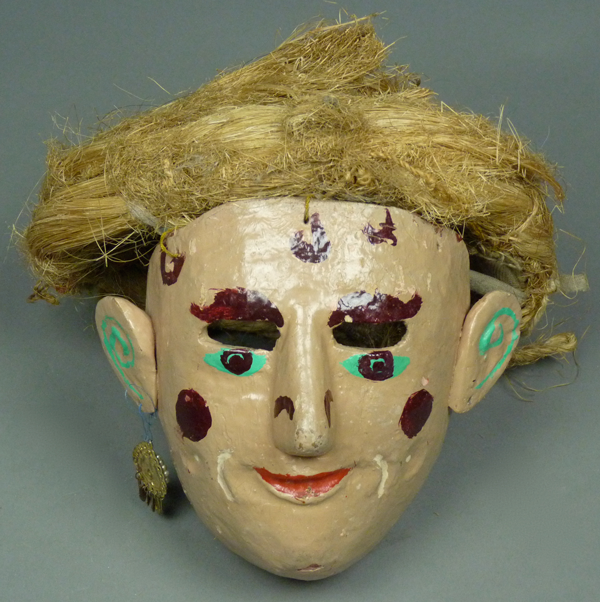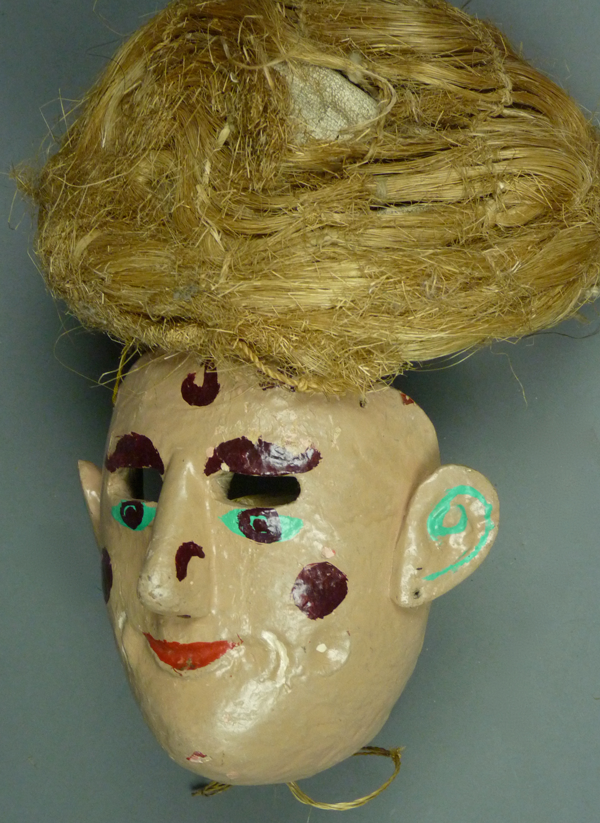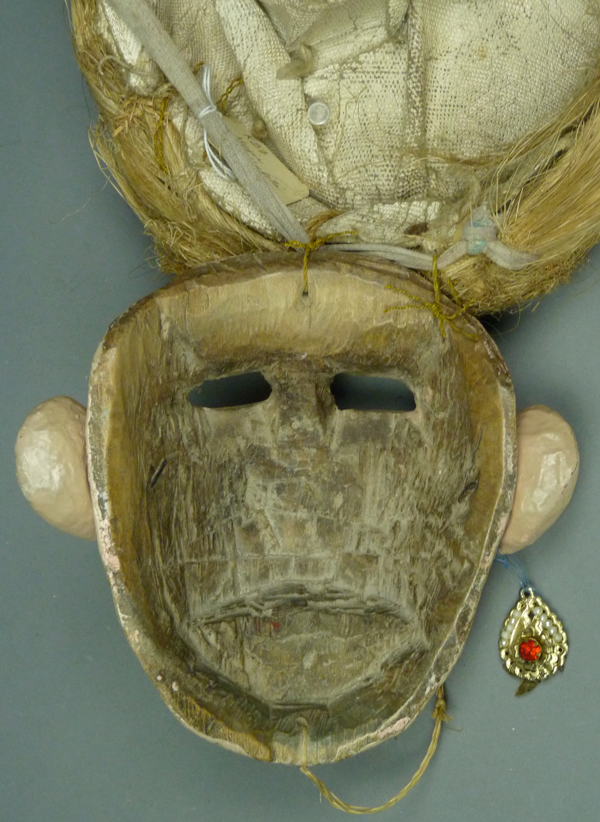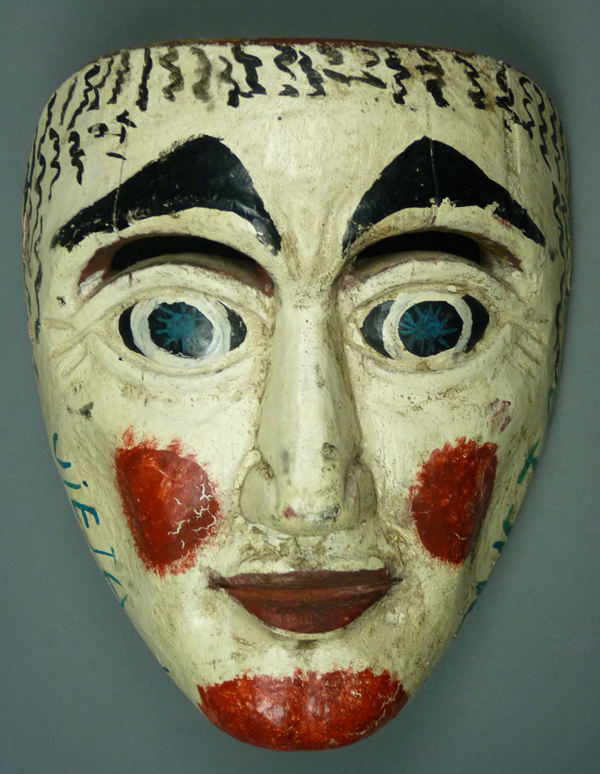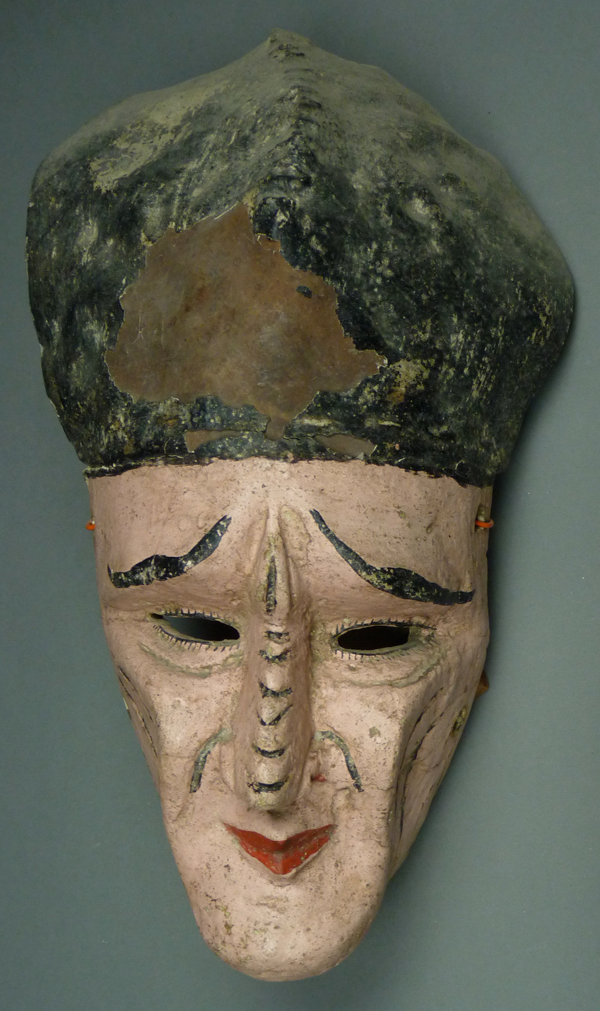As a Mexican mask collector, I have always felt drawn to groups of masks, such as those from a particular village, those by one carver, or those from a particular dance. Such groups permit one to see patterns and differences.
When I first read Mexican Masks (by Donald Cordry), I became interested in masks from the Mexican state of Guerrero. Of course many of the decorative masks came from Guerrero, but I decided to focus on the many authentic masks that also came from that state. The Guerrero carvers had a long tradition of masks that were deliberately over-sized for dramatic effect, a quality that I found interesting.
I also found it interesting that there were masks of females in traditional Mexican dances. Writing about the dances in Michoacán, Janet Brody Esser (1978, volume 1, pages 10 and 71) provided an enlightening perspective on the characters in Mexican dances. Briefly, almost all masks in Michoacán (and throughout Mexico, as I have come to discover by exploring her ideas) fall squarely into one or the other of two contrasting groups—”the beautiful and the ugly.” By beautiful Esser is referring to noble or idealized figures, such as saints, while ugly is associated with imperfection, ignorance, irreverence, malice, and associated personality flaws. In such a system, there are no ordinary people, only caricatures that represent extremes. Therefore it should come as no surprise that most of the female masks found in Mexican dances represent either an idealized figure or saint, such as the Virgin Mary, or a negative character, such as a degraded woman, a clown, or a diabla (female devil).
Today I am going to present a small selection of female masks from Guerrero; I wish I had more.
The first is a mask of Malinche, said to have been used in the dance of the Ocho Locos (the eight fools) in Teloapan, Guerrero. I bought this mask from Spencer Throckmorton in 1996. According to Estela Ogazon, in Máscaras (1981, 87), the plot of this dance centers on a Friar who must manage a group of characters who possess various weaknesses. They “wear grotesque masks, and dress in an inane manner to characterize various sins.”
The female face of this mask has been deliberately carved to be unattractive. The height of this mask is 7½ inches, the width is 6 inches, and the depth is 4½ inches.
For example she has a long nose and prominent teeth.
This mask is old and heavily worn. note the repairs—a tin plate and the hardware on top that bridges a split in the wood.
I am attributing the next mask to Guerrero. It was purchased from a dealer in New York City, but I bought it on EBay from a subsequent owner, who thought that this mask was a Viejito from Michoacán. I disagree, because it lacks the typical Viejito grin, there are no holes across the top for the attachment of a wig, the back is not carved with visible chisel marks as I have often seen on masks from Michoacán, and I am convinced that this is a mask of a woman. I bought the mask based on my impression of such alternative possibilities. To my eye, this may be a rare and wonderful old mask of Malinche or a related figure from the state of Guerrero. I do not know with certainty which dance she appeared in and there are at least four possibilities—the Ocho Locos that the last mask appeared in, the Tres Potencias that was the vehicle for the mask that follows, a combat drama, the Tenochtli dance, and the Danza del Tigre, as presented by the Amusgo Indians. On reflection, the face of this mask does not project the wildness that would be necessary for the Ocho Locos, nor the purity of the Tres Potencias. It has an anxious weary quality that makes me consider the last two dances on the list.
Of the Tenochtli dance, Estela Ogazon wrote (1981, 89) that the mask worn by the Malinche character has a red face, so I think it possible that this mask might have come from the Tenochtli dance. Estela supplied a brief description of the plot, as follows. Malinche appears in the dance on the arm of her husband, but Cortez intends to take her for himself, and eventually he abducts her. The Tenoch has the appearance of a Mexican cowboy, but Ogazon does not explain the part that he plays. The action takes place in the company of Indians and Conquistadors who are apparently dancing in two opposing and parallel lines, as if they might be in combat. Donald Cordry had provided a dance photo of the Tenochtli drama (1981, 220-221). In the version that he observed, the cast included the mother of Malinche and a Huiquixtle (ritual clown). From these accounts I realized that this mask might have been worn by Malinche or by her mother—Abuela Teresa. The inherent uncertainty in this riddle comes from the tendency to portray Malinche in unflattering terms, versus the possibility that when paired with her mother, Malinche might be portrayed as young and beautiful and her mother as elderly and concerned. One sees such a pattern in the Manueles dance—the beautiful young bride and her elderly mother. If we could be certain that Malinche was appearing in the Tenochtli dance as a beautiful young woman, then it would be easy to assume that our current mask was worn by Abuela Teresa.
But then there is la danza del Tigre y los Tlaminques (the jaguar and the townspeople) in the Amusgos villages, such as Xochistlahuaca, San Pedro Amusgos, and Guadalupe Victoria. A YouTube™ video of this dance in Xochistlahuaca opened my eyes to the liklihood that this mask might have been used in that dance tradition. As is often the case in these Tigre dances, the dancer wearing a Jaguar mask and suit is quick to menace all those within reach, most frequently the other dance characters, but also provacative children in the audience. In the video we see a dancer wearing a pink old woman’s mask, a white blouse, a long skirt, and a tattered traditional rebozo (shawl). This is Doña Catalina, She repeatedly provokes and attacks the Tigre figure, as if she sees herself as the lone defender of the village. Of course the mighty Tigre knocks her to the ground and pretends to savagely attack her. The bystanders watch this encounter with obvious amusement. Here is a link to the video.
https://www.youtube.com/watch?v=WFJ4HJjQ10E
The height of this mask is 10 inches, width is 7 inches, and depth is 5 inches.
This is yet another old mask that demonstrates evidence of prior infestation by wood-boring insects. The differential staining on the back suggests that this mask has been heavily used.
I obtained the next mask in 1994 from the Cavin Morris gallery in New York City. It was said to be a mask of Alma Potoicha from la danza de las Tres Potencias (the dance of the Three Powers) in Altamirano, Guerrero. While the meaning of Potoicha is unclear (it is the name of a remote town in Guerrero and I have been unable to find any other translation), Alma is the Spanish word for soul, which is indeed the name of one of the characters in this dance. I had always assumed that the three powers referred to in the dance were God, Satan, and death, or some such monumental adversaries, but Estela Ogazon began her description of this dance (in Máscaras, 1981, 87) by explaining that the soul has three powers—”memory, understanding, and will.” In addition to the soul there are many other characters in the dance of the sort that I had anticipated, including “sin,the angel, the devil, death, the flesh, the Virgin, Christ, and Lucifer.” The dance ends with “the triumph of the soul which then ascends to heaven.”
A very rare document from 1716, Conversion de las tres potencias del alma, explicada en el primer sermon predicado a los muy nobles sennores congregados inteligentes en la lengua espannola [The conversion of the three powers of the soul …], by Antonio Gavin, is available in facsimile from an original copy in the British Library. This document appears to have provided the inspiration for this dance and offers further explanation about its intellectual and religious roots. Briefly, all three of the soul’s powers must participate in the soul’s conversion to Christianity for salvation to follow. First the soul must develop an understanding of the nature of sin versus God’s laws, then will must insure that the soul begins a new life based on this knowledge. Memory has a different part to play; the soul must learn to forget the sinful pleasures of the past. Thus it is clear that the dance of the Three Powers was designed by the missionaries as a teaching instrument.
Here is the mask was worn by the character who represents the soul in the dance of the Tres Potencias in Altamirano, Guerrero.
The height of this mask is 8 inches, width is 6 inches, and depth is 4 inches.
The back demonstrates a mild pattern of differential staining.
The next female mask is from the Mulita dance, in Zitlala, Guerrero. I bought this mask from René Bustamante in 1994. I found a dance photo of this dance in a book- En el mundo de la máscara, on page 79, and I also found a photo online in La Jornada, September 11, 2009, of a Mojiganga in Zitlala, a female clown wearing a similar mask.
http://www.lajornadaguerrero.com.mx/2009/09/11/
Here are photos of this mask. It has been heavily used, and repainted at least one time, if not more.
The ears on this mask were carved separately and applied. One of the earrings has been lost. The wig was constructed on the crown of an old hat. Note the carved details that were meant to indicate dimples. The round recessed areas would have been painted red in the past, but now they have been painted over.
The height of this mask is 6½ inches, width is 7 inches, and depth is 3½ inches.
The extensive wear on the back of this mask is evident.
In this survey of female masks from Guerrero, I will only briefly mention two other masks that you might have seen in earlier posts. The first is the “Vieja la Roquete”. The second is the character “Time”from the Manueles dance.
Vieja la Roqueta. I am guessing that this mask was worn by a Maringuilla figure in a combat dance, although I have no definite information.
The height of this mask is 10 inches, width is 8 inches, and depth is 4 inches; it is oversized.
Time, from the Manueles dance. The height of this mask is 12½ inches with headdress and 7 inches without, width is 5 inches, and depth is 3 inches.
Even in this very limited series one can see the variety of female masks that are found in the Mexican state of Guerrero. Next week I will discuss some traditional Diablo masks from Guerrero.



